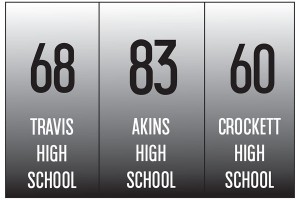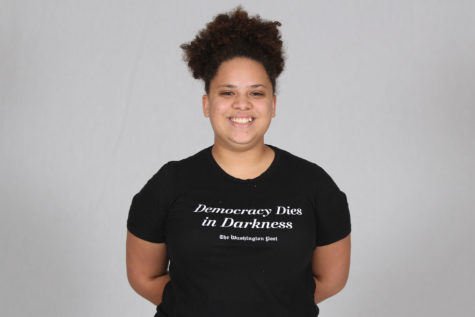More resources available to homeless students
Seniors Tammy Nguyen and Yocelyn Erazo hang up posters for the Winter Clothing and Healthy Living Drive. Boxes were placed around campus with the hope of having students donate items that would help both homeless students and financially unstable students.
December 2, 2016
There are 2,642 recorded homeless students in the Austin school district according to a recent survey conducted by the HousingWorks non-profit organization.
That boils down to about 3 percent of all Austin ISD students, which might not seem like much. But that is the same percentage as the number of mixed-race students in the district and one percent less than the number of Asian-Americans. Most students know at least one person that fits those specifications.
There are specific district criteria for categorizing a student as homeless: being “doubled-up,” (living with another family), living in a hotel or motel, staying with friends (also referred to as “unaccompanied youth”), or living in shelters or vehicles. As of now, there are currently about 30 students at Akins that have been identified as fitting these descriptions.
“Last year we had around 120 (homeless) students, so that tells me that we haven’t identified all the youth this year who are in need,” said Meg Mattingly, project supervisor for AISD’s Project HELP.
Project HELP is a district initiative put in place to implement the McKinney-Vento Act, which is a federal law that attempts to remove barriers for homeless students. It provides them with resources they might not otherwise have, including school supplies, Wal-Mart gift cards, other supplies, and access to transportation in the form of bus passes. Mattingly said the law also details rights that homeless students have.
“Their children have the right to stay at the school that they are at, no matter where they’re at,” she said. “And the reason for that is the way the law is set up. It’s helping to remove any barriers. So if a child is experiencing a lot of instability in their home life, the law is in place to make sure they’ll at least have that stability at school.”
In addition to the services available through Project HELP, Akins itself has resources and programs available to help homeless students. Graduation coach Laura Garza works with some homeless students who have attendance problems, which can take them off-track to graduate.
“A lot of our students who are homeless are at risk for dropping out because it’s hard for them to get to school everyday,” Garza said.
Akins also offers services to homeless students through Student Support Services, or SSS. SSS is run by social worker Colleen Arnold and her interns. Arnold’s office works with homeless students to get them necessities such as backpacks and school supplies and clothing. There is a clothing closet on campus as well as a connection provided to students via Assistance League of Austin to provide students with clothes from Target. Arnold said SSS also receives donations for homeless students from Manchaca United Methodist Church.
“They’ve helped with paying AP exam fees and college admissions application fees for homeless students,” she said. “We try to partner with people in the community who have a heart to serve students and get connections with all of our students in whatever it is.”
Another source of clothing for homeless students is the Winter Clothing and Healthy Living drive, organized by students in the Austin Corps class. Senior Tammy Nguyen and others are collecting donations in boxes around campus. Nguyen is collecting winter clothing and hygiene products until November 15. The proceeds will go to a drive to benefit homeless students. She is also organizing a Student Resource Room open to all students, which will provide clothes and test prep books.
“What I hope about all of these initiatives is that people will change the way that they think about students in need,” Nguyen said. “I wanted to do this because we have a lot of homeless students, but we also have a lot of students that are financially unstable.”
Mattingly said that many people don’t know about the resources they can get through Akins and Project HELP. She said it’s important to get their information out so the stigma of homelessness is removed.
“It’s really cool that Akins sees such a value in this, and an importance of understanding the needs of students at your school,” Mattingly said. “I hope that we can change the language of the conversation because I think there’s a lot of shame around it and embarrassment.”









